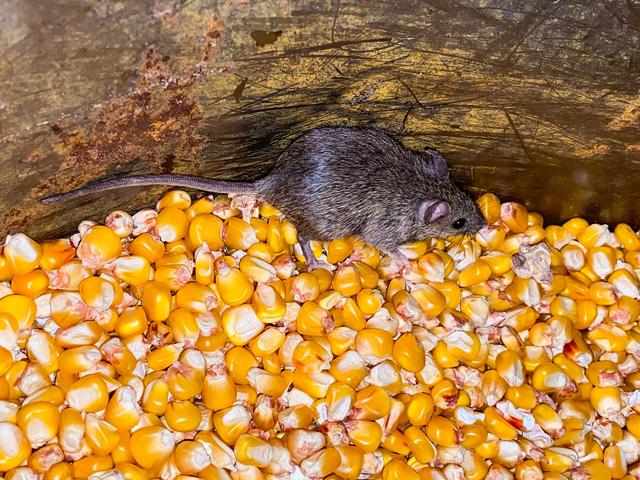How to Get Rid of Mice, Other Rodents
Tips on How to Catch Mice and Prevent Rodent Problems on Farms
OMAHA (DTN) -- They might not know what a polar vortex is, but mice and other rodents definitely know when it's time to seek warmer shelter. Unfortunately, usually, that means them scurrying into people's homes, farm shops and machinery.
When temperatures plunged last week, stories rose of people finding out they had mice infestations and trying to figure out what to do next.
WHEN CREATURES ARE STIRRING
On Dec. 23, during a bitter cold night, my friend Karen walked into her Midwest home kitchen and spotted a mouse desperately leaping and trying to jump out of the deep sink she had there. She figures he ran over the countertops and jumped into the sink for some of the water she had leaking there to keep her water pipes from freezing -- then the mouse couldn't climb back out. She caught him, got him out of her house and hoped that was the end of the problem.
However, on Dec. 24, another one appeared. "I saw him run across the corner of the kitchen floor, just a little mouse. He was just a bold little guy!" exclaimed Karen.
She found more telltale signs of mice and put out sticky traps. Karen discovered one of the mice soon dragged a sticky trap with him as he ran off, dived under the fridge -- and disappeared somewhere that Karen and her sons couldn't find even after moving the fridge.
Christmas Day, while her family visited, there was a lot of activity in the house with grandkids running around -- and not a single mouse appeared to be stirring.
However, on Dec. 26 at the crack of dawn, Karen's daughter-in-law, still half asleep, heard a little scratching sound and became conscious -- and then a mouse jumped out of a box that was on the floor in her bedroom.
More sticky traps and other traps have been set since then with enticing peanut butter. As of Dec. 28, Karen said the mice ate all the peanut butter in the traps -- but escaped being trapped.
Farmers and ranchers can probably relate to this battle with rodents, especially when colder weather arrives.
While having a hungry farm cat that's a good mouser is like setting off a heat-guided missile aimed at mice, that isn't the only option.
A few years ago, DTN/Progressive Farmer's Ask The Mechanic columnist Steve Thompson was asked for advice about rodent control around machinery. The reader shared some details about the rodent damage he was dealing with: "I have spent thousands on repairs on electrical wiring, components, and cab interiors. I was planning on the poison bait, but we have dogs. I wanted to get a cat or two, but my dogs don't like cats."
Progressive Farmer Senior Editor Dan Miller wrote a blog about the topic and Thompson's advice, but also added a list originally from the Titan Outlet Store in Moorhead, Minnesota, for dealing with rodents.
TITAN'S TOP 10 LIST TO MANAGE RODENT DAMAGE:
1. Clean your equipment. Sweep and blow out all the grain, chaff, food wrappers, uneaten candy and cartons from your tractors and combines after harvest.
2. Properly maintain landscaping. Trim overgrown shrubbery, weeds and grass around the home place -- especially remove overgrown greenery growing against your machine shed and other outbuildings.
3. Remove debris. That includes rock and wood piles, general trash and worn-out equipment past any hope of usefulness.
P[L1] D[0x0] M[300x250] OOP[F] ADUNIT[] T[]
4. Elevate lumber and firewood off the ground. These are rodent havens. Keep lumber and firewood at least 18 inches above the dirt -- and keep these areas free of greenery.
5. Locate openings in your cab. If you find holes, even holes no bigger than the diameter of a No. 2 pencil, plug them with putty, caulk or foam. Yes, mice can wiggle through holes that small.
6. Don't park underneath trees. Rodents are great climbers, and they will drop down into your hoppers and onto your cabs.
7. Get a barn cat. Get a hungry barn cat. A hungry cat is a great mousing cat. Titan notes that Jack Russell terriers are also known to be great rodent killers.
8. Set those old-fashioned, spring-loaded traps. You'll catch rodents, but it's a bit like pushing back the ocean. Traps are not very efficient in the face of large rodent infestations.
9. Poison them. OK ... unless you have barn cats and dogs. Poisoned rodents may also kill the barn cats. Poisoned rats and mice also smell.
And, No. 10: There are home remedies ... dryer sheets (fresh air and scented will do -- and make your cab smell pretty), mothballs and sulfur.
MORE SUGGESTIONS SENT BY READERS
After the first column about dealing with mice, Miller and Thompson asked readers to share their solutions to the question of "how to build a better mouse trap" -- or to prevent mice in the first place.
Suggestions poured in. While most of the suggestions are targeted at rodent problems around machinery and shops, a few ideas can also be applied to keep them out of your homes.
The following was from a second column Thompson wrote of the ideas he received:
-- Ken Pippin, Geneva County, Alabama. Sprinkle crushed red pepper on the wires and along rodent trails.
-- Alfred Will, Montrose, Illinois. Put grease on the wires. Central Petroleum Company's grease works great.
-- Bev Allen, southeastern Wyoming. Sprinkle cut or ground bars of Irish Spring Original Soap in your machines.
-- Richard King, Bastrop, Louisiana. Mix a half-cup of vinegar with one and a half cups of water and 20 drops of peppermint oil and spray on the thresholds and windowsills.
-- Bob Feuss, Lost Nation, Iowa. Place a few mothballs in the cabs and on the motors.
-- Francis and Helen Puype, Greeley, Colorado. Place Bounce dryer sheets around the machinery.
-- Keith Wilbanks, Plano, Texas. If I disconnect the batteries on equipment stored for winter, mice seem to leave it alone. The electrical circuit puts off a buzz that attracts mice.
-- Milly Welsh, Davidsonville, Maryland. Place rodenticide in a piece of PVC pipe. Cap the ends and cut a hole in the end caps that will allow a rodent to crawl in and eat the bait (make sure the hole is too small for a dog or cat to get to the bait).
-- David Mertell, Independence, Missouri. Hang cow fly/insect tags around the place using zip ties. Hang them around engine area, under dash, glove box, behind seat, and in toolboxes.
-- C. G. Cleveland, Paradise, Texas. Place Glue Boards in cab and in tight areas under hood, behind wiring harnesses, and behind instrument panel.
-- Kenny Robertson, Brownsboro, Texas. Throw salt on the floor of the cab. Throwing some rock salt around bales of hay stored outside also keeps the mice away. It burns their feet.
-- Dennis Immel, Adair, Iowa. Place 6-inch aluminum siding on its side in a circle around tires on cars, RVs, tractors, combines on a concrete floor. The siding works great and is clean and safe for animals.
-- Gaylon Pasley, Trenton, Texas. I use big mousetraps. The poison that I buy these days is too weak for Texas-sized rats!
-- Ralph Hove, Fosston, Minnesota. Place drops of oil of peppermint (not extract) on cotton balls and leave them in cabs and under hoods.
-- James Garner, Spiceland, Indiana. Tape treated baler twine to wiring harnesses to stop damage. A small ball of treated twine around wiring harnesses, in cabs and control boxes will keep mice away.
-- Jim and Karen Naylor, Dayton, Idaho. Stuffing Bounce dryer sheets under dash, between seats and under seats makes cab smell good in trucks and mice stay away even in grain trucks.
-- Danny Gentry, Princeton, Missouri. Get a couple of chickens. They will catch more mice than a cat. Plus, chickens will leave you an egg or two for breakfast. Cats don't do that.
-- J.W. Willis, Elm Grove, Louisiana. The best thing I have ever found is a Victor PestChaser (Google it. They're real and they kill cockroaches, too). A solution if you do not have electrical supply is to take a 5-gallon bucket with a lid. Bore a 1 1/4-inch hole at the bottom and put large chunks of rodent bait in the bucket. Pets and wildlife cannot get to poison in the hole. That works great!
Do you have any new successful ideas on controlling rodents but aren't on the list? Send them to talk@dtn.com or share them on our DTN/Progressive Farmer Facebook page. We welcome your feedback.
To see the original blogs in their entirety, go to:
"Of Mice and Machinery," https://www.dtnpf.com/…
"Build a Better Mouse Trap: 18 Ways to Rid Your Machinery of Wire-Damaging Mice," https://www.dtnpf.com/…
Elaine Shein can be reached at elaine.shein@dtn.com
Follow her on Twitter @elaineshein
(c) Copyright 2022 DTN, LLC. All rights reserved.



